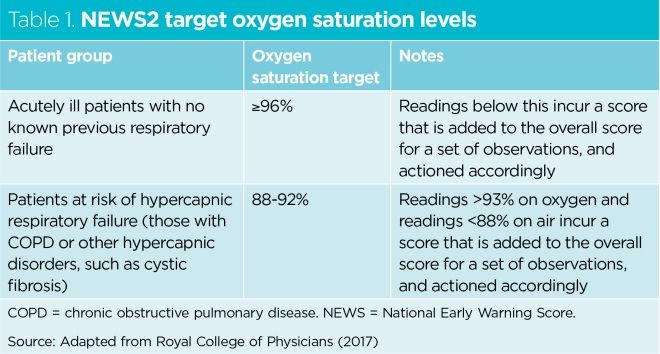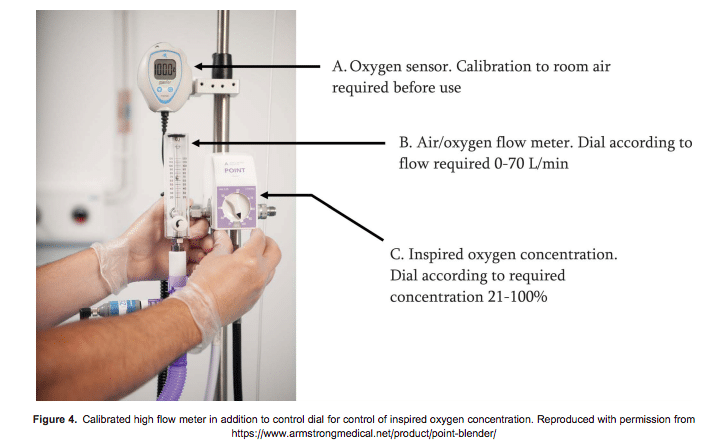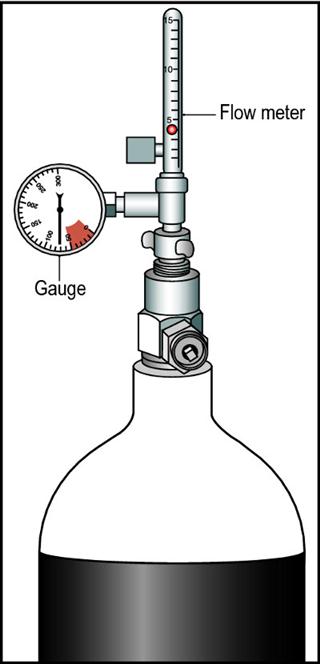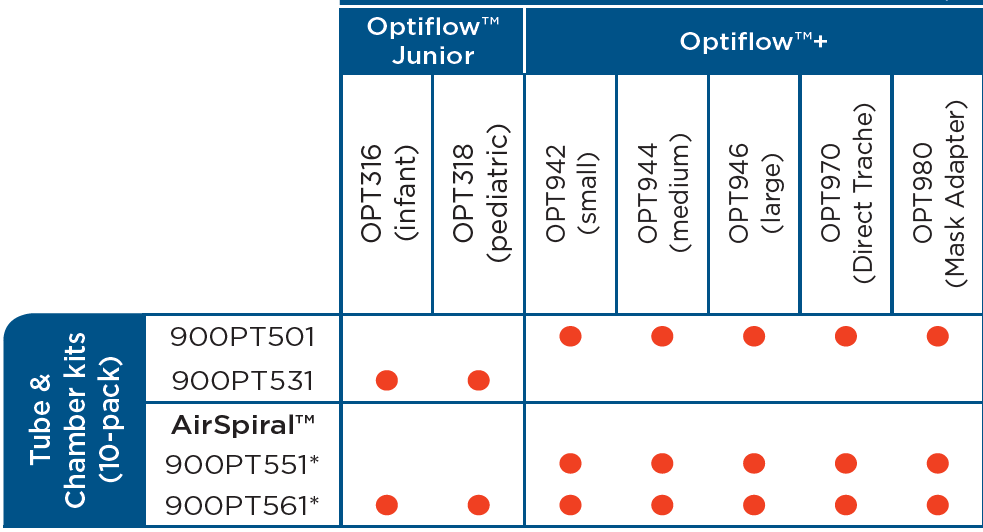oxygen delivery devices and flow rates uk
1L 24 2L 28 3L 32 4L 36 5L 40 6L 44. Very commonly used among the oxygen delivery devices in wards.

Ensuring The Safe Use Of Emergency Oxygen Therapy In Acutely Ill Patients Nursing Times
If you need a higher flow rate of oxygen its likely you will need a face mask.

. Higher flows 4 Lmin make it uncomfortable for the patient. This video - produced by students at Oxford University Medical School in conjunction with the faculty - demonstrates how to deliver oxygen therapy through va. It is NOT the Lmin stated on the venturi that is delivered to the patient.
Oxygen use has extended from inpatient to outpatient settings for patients with chronic pulmonary diseases and complications of hypoxaemia. 3435 when hfnc flow is less than the inspiratory flow the patient also inspires. The percentage of oxygen inspired depends on the flow rate and the delivery device.
Stationary and portable 9 10. The oxygen flow rate delivered by liquid oxygen canisters may be less than intended owing to inaccuracies of the set flow rates andor as a result of the outflow resistance caused by the humidifier oxygen tubing delivery or conserving device. The advantages and disadvantages of nasal cannulae are summarised below.
1 to 6 liters. The oxygen flow rate. However when breathing with the NRB an O 2 flow rate of 15 Lmin-1 is required to reach these levels.
60l per minute high flow breathing machine. Lmin 1 Resultant oxygen concentration. A typical oxygen concentrator may deliver oxygen flows of 055 Lmin 1 low-flow oxygen concentrators while some models may generate up to 10 Lmin 1 high-flow oxygen concentrators 9 10.
Oxygen Delivery Devices Delivery Device Minimum to Maximum Liter Flow Range Adults Approximate O2 Delivered Notes RT assistance recommended for liter flows of 6 litersminute or more. They include Nasal cannulae. Types of oxygen concentrators and oxygen delivery There are two types of oxygen concentrators.
Peak nasopharyngeal F I O 2 was highest with the NRB with a flow rate of 15 Lmin-1 Table 3 though 10-min P tc O 2 values were similar for each device. The nasal cannula is the most common oxygen device utilized. Ideal for short term use for neonates and infants.
Avg flow 10-15 ltmin results in 80-90 oxygen conc. The aim of this study was to investigate the accuracy of oxygen delivery by liquid oxygen. Depending on a patients inspiratory effort tidal volume speed of inspiration and respiratory rate the PIFR can often exceed the flow rate at which oxygen or an oxygenair mixture is supplied by the device meaning that at the time of PIFR.
The flow rate can be set on the wall tap. A flow rate of 2 liters per minute increases the FiO2 from 21 percent room air to. O2 and air premixed passed through heated humidifiers.
The of oxygen delivery depends on the flow rate and the delivery device. Prompt clinical assessment is required if oxygen therapy needs to be initiated or increased due to a falling saturation level. A higher FiO2 can be achieved with flow rates up to 6 Lmin if tolerated.
Oxygen delivery devices Flow rate litremin Approximate FiO 2. Oxygen therapy can be delivered using a low flow or high flow system. It varies from 0 15L per minute.
The of oxygen delivery depends on the flow. The nasal cannula is a device that has two prongs that are placed in the patients nostrils and deliver oxygen at flow rates of 1 to 6 liters per minute. Nasal cannulae Teleflex Medica 1.
Hudson mask Teleflex Medical 56. High Flow Oxygen Devices Cost. Pediatric oxygen delivery system Oxygen hood Covers only head allowing access to the lower body.
Low flow device most common device used for mild hypoxia can be set between 1 and 6 lpm 24 to 40 fio2 fio2 increases approximately 4 with each liter of o2 korupolur gj needham dmcontemporary criticalcare. The type of humidification device selected will depend on the oxygen delivery system in use and the patients requirements. Nebulizers should be avoided.
NASAL CANNULAE oxygen delivery device NASAL CANNULAE ADVANTAGES AND DISADVANTAGES. The formula is fio2 20 4 oxygen liter flowThe main type of oxygen deliver device are outlined belowThe nasal cannula nc is a device used to deliver supplemental oxygen or increased airflow to a patient or person in need of respiratory help. All high flow systems require humidification.
Designed to entrain a set amount of O2 and air which combine to produce a set flow of O2 the stated on the venturi. The humidifier should always be placed at a level below the patients head. Oxygen delivery device Oxygen flow rate.
Low flow O2 delivery device 05-6 Lmin. 200969111 Bailey P Thomsen GE Spuhler VJ et alCrit Care MedJan2007351139145. 2 flow rates of less than 2 L O 2 lmin or if minute ventilation is very high 4 Lmin of oxygen flow delivers an FiO 2 of about 03504 providing there is a normal respiratory pattern Flow rates greater than 8Lmin do not increase FiO 2.
Low flow device Most common device used for mild hypoxia Can be set between 1 and 6 LPM 24 to 40 FiO2 FiO2 increases approximately 4 with each liter of O2 KorupoluR GJ Needham DMContemporary CriticalCare. Weaning and discontinuation of oxygen therapy. These devices deliver a variable inspired oxygen concentration to the patient which depends on the PIFR.
After compressing and removing nitrogen the machine delivers 90 to 95 pure oxygen and 5 to 10 nitrogen. What is a nasal cannula. Hudson Nonrebreather Teleflex Medical 1012 80100.
This program explores the factors that influence oxygen delivery to the tissues. Oxygen delivery devices and flow rates should be adjusted to keep the oxygen saturation in the target range. Flow rate 1-4Lmin 4L will dry the nose 2L is more comfortable.
Higher flows 4 lmin make it uncomfortable for the patient. Excelsior Cpne Documentation Nursing School Studying Nursing Notes Nursing Study. They can deliver between 2435 oxygen with flow rates of 24 Lmin.
This article presents an overview of oxygen devices oxygen concentrators compressed gas cylinders and liquid oxygen and delivery systems high- and low-flow. Oxygen saturation and delivery system including flow rate should be recorded on the patients monitoring chart. Delivery devices work with different flow rates.
Oxygen delivery devices and flow rate Perfusion Mobile App. This program examines the art of perfusion and how the perfusionist.

Covid 19 And O2 Therapy Initial Prehospital Approach In Mild Symptomatic Patients Medest

Oxygen Delivery In The Home Setting

Oxymask Versus Traditional Oxygen Devices Download Table

High Flow Noninvasive Ventilation And Awake Nonintubation Proning In Patients With Coronavirus Disease 2019 With Respiratory Failure Chest

Oxygen Delivery Devices Chapter 10 Diagram Quizlet
Clinical Guidelines Nursing Oxygen Delivery

Oxygen Therapy And Delivery How To Prescribe Oxygen Youtube

Types And Characteristics Of Oxygen Delivery Devices Download Table

Oxygen Delivery Devices Ati Flashcards Quizlet
Mitchell Home Medical Referral Help

Preoxygenation Deoxygenation And Reoxygenation During Intubation

High Flow Oxygen In Anaesthesia And Critical Care Wfsa Resources

Types And Characteristics Of Oxygen Delivery Devices Download Table




